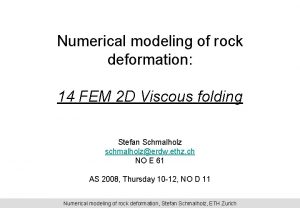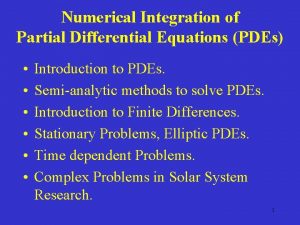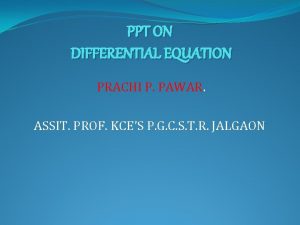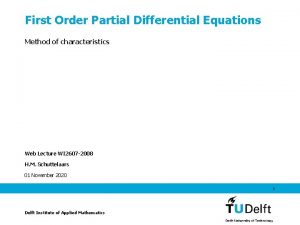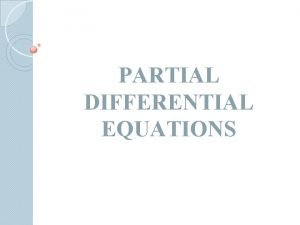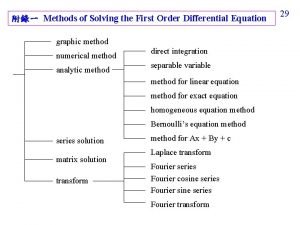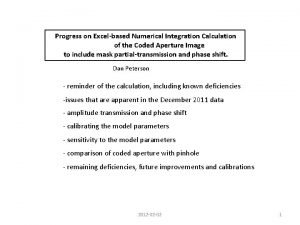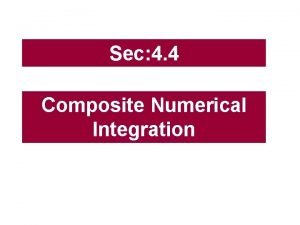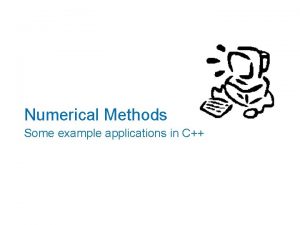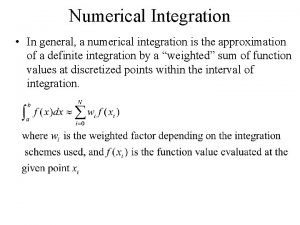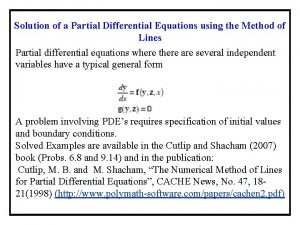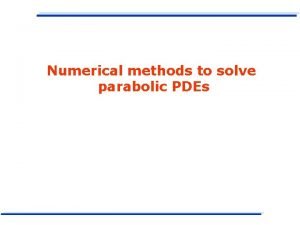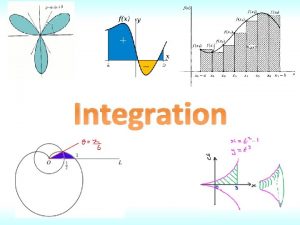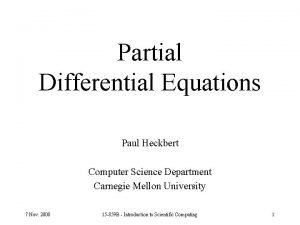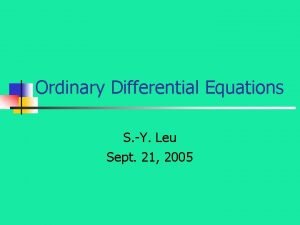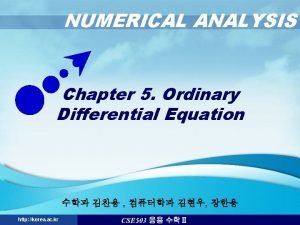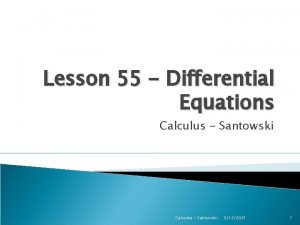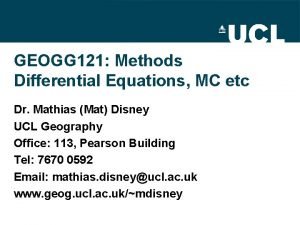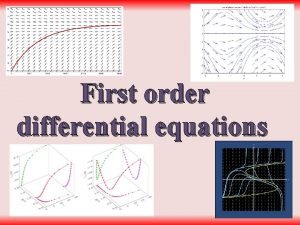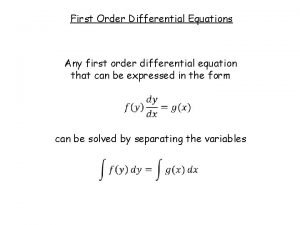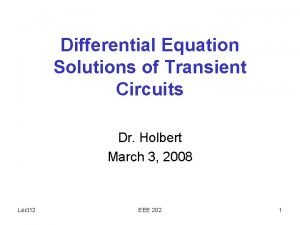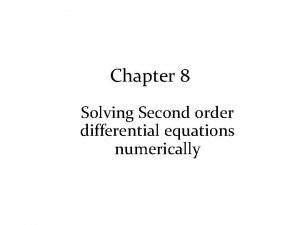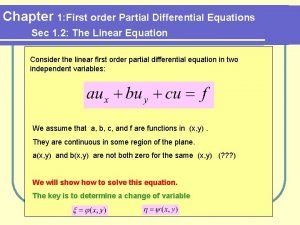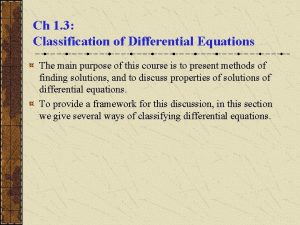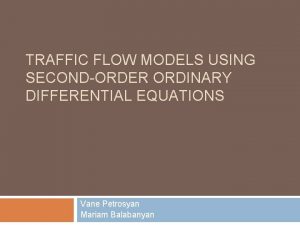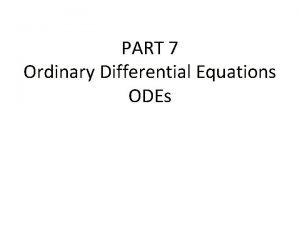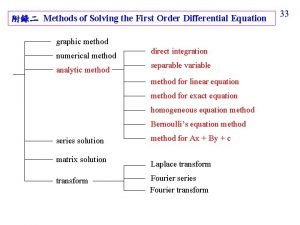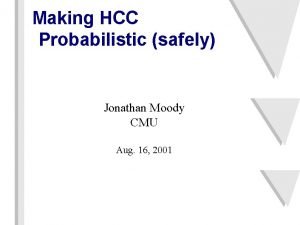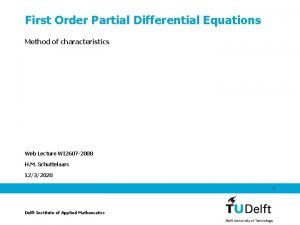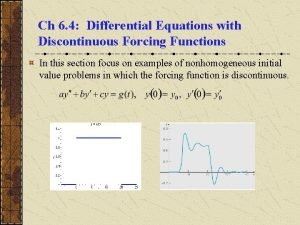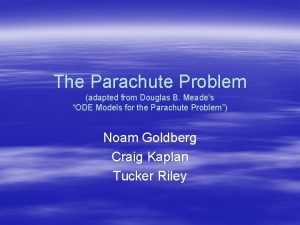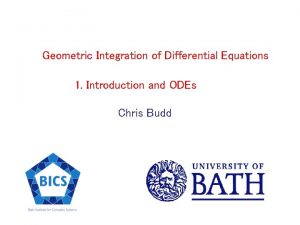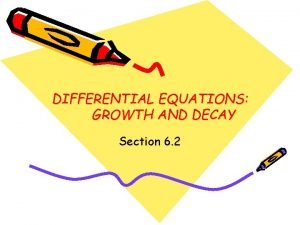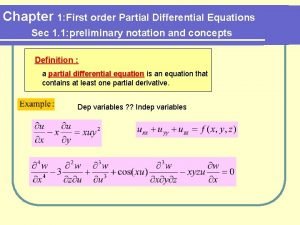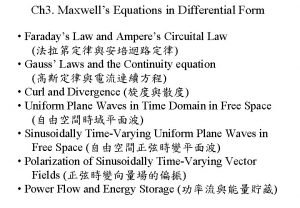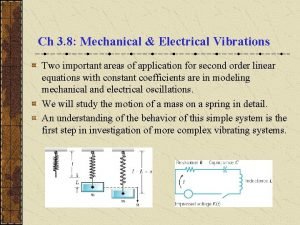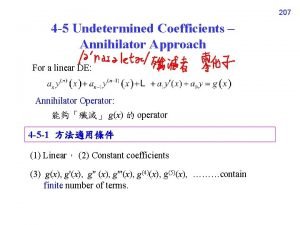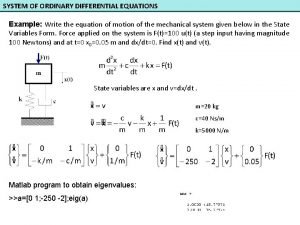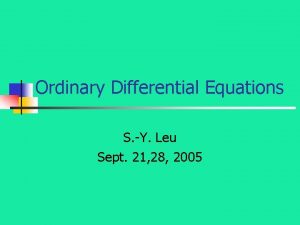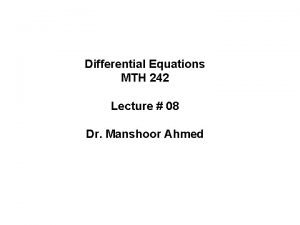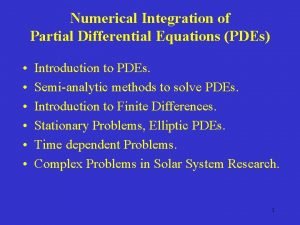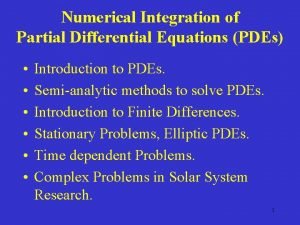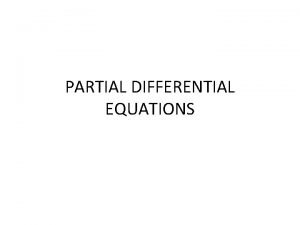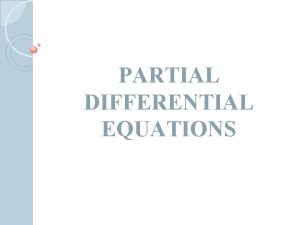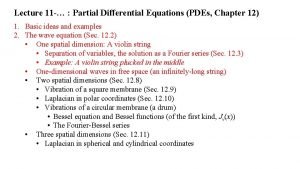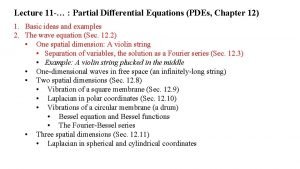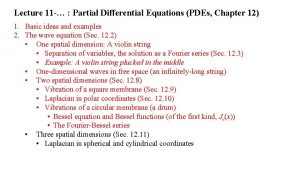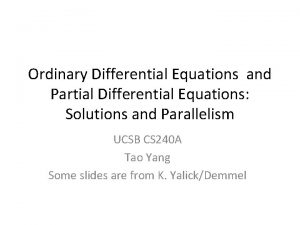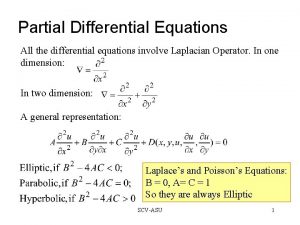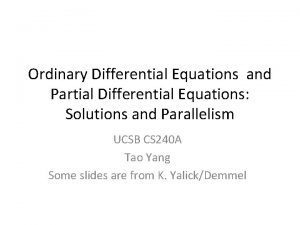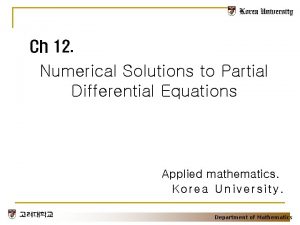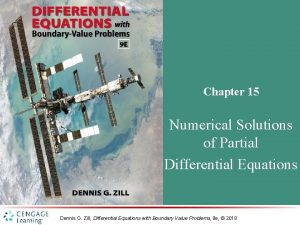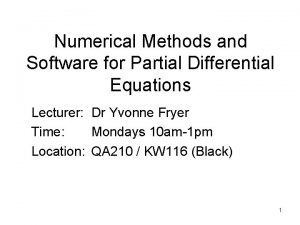Numerical Integration of Partial Differential Equations PDEs Introduction
























































- Slides: 56

Numerical Integration of Partial Differential Equations (PDEs) • • • Introduction to PDEs. Semi-analytic methods to solve PDEs. Introduction to Finite Differences. Stationary Problems, Elliptic PDEs. Time dependent Problems. Complex Problems in Solar System Research. 1

Stationary Problems, Elliptic PDEs. • Example: 2 D-Poisson equation. • From differential equations to difference equations and algebraic equations. • Relaxation methods: -Jacobi and Gauss-Seidel method. -Successive over-relaxation. -Multigrid solvers. • Finite Elements. 2

3

4

Boundary value problems for elliptic PDEs: Example: Poisson Equation in 2 D We define short notation: After discretisation we get the difference equation: 5

Equation holds on inner points only! On the boundary we specify: -u (Dirichlet B. C. ) or -Derivative of u (von Neumann B. C. ) 6

How to solve the difference equation? We can interpret u as a vector and write the equation formally as an algebraic matrix equation: • Theoretical one could solve this algebraic equation by well known algebraic equation solvers like Gauss-Jordan elimination. • This is very unpractical, however, because A is very large and contains almost only zeros. 7

How large is A ? • For a very moderate 2 D-grid of 100 x 100 -u has 100 x 100= 104 gridpoints, but -A has 104 x 104 =108 entries! • For 3 D-grids typically used in science application of about 300 x 300 -u has 3003= 2. 7 *107 gridpoints, -A has (2. 7 *107 ) 2 =7. 29*1014 entries! => Memory requirement for 300 -cube to store u ~100 MB, A~3 Million GByte 8

Structure of A ? 0 0 9

How to proceed? • We have reduced our original PDE to algebraic equations (Here: system of linear equations, because we started from a linear PDE. ) • To do: Solve these equations. • As exact Matrix solvers are of no much use we solve the equations numerically by Relaxation methods. 10

Relaxation: Jacobi method From Carl Jacobi 1804 -1851 we derived the algebraic equations: Assume any initial value, say u=0 on all grid points (except the specified boundary values of course) and compute: Use the new values of u as input for the right side and repeat the iteration until u converges. (n: iteration step) 11

Relaxation: Jacobi method • Jacobi method converge for diagonal dominant matrices A. (diagonal entries of A larger than the others) • This condition is usually fulfilled for Matrix equations derived from finite differencing. (Tridiagonal block matrix: Most entries in A are zeros!) • Jacobi method converges (but slowly) and can be used in principle, but maybe we can improve it? • For practice: Method should converge fast! 12

Gauss Seidel method • Similar as Jacobi method. • Difference: Use on the right-hand site already the new (and assumed to be better) approximation un+1, as soon as known. C. F. Gauss 1777 -1855 13

How fast do the methods converge? To solve: We split A as: Lower Triangle Diagonal Elements Upper Triangle For the rth iteration step of the Jacobi method we get: 14

How fast do the methods converge? We have to investigate the iteration matrix Eigenvalues of iteration matrix define how fast residual are suppressed. Slowest decaying Eigenmode (largest factor) defines convergence rate. => Spectral radius of relaxation operator. 0< <1 How many iteration steps r are needed to reduces the overall error by a factor of 10 -p ? 15

How many iteration steps r are needed to reduces the overall error by a factor of 10 -p ? In general: For a J x J grid and Dirichlet B. C. one gets: Jacobi method Gauss Seidel method 16

Can we do better? Gauss Seidel iteration: Can be rewritten as: 17

Successive Overrelaxation (SOR) Now we overcorrect the residual error by overrelaxation parameter Method is only convergent for 0<w<2. (for w<1 we have underrelaxation) Aim: Find optimal overrelaxation parameter. Often done empirically. 18

Successive Overrelaxation (SOR) For the optimal overrelaxation parameter w the number of iteration steps to reduce the error by 10 -p are: Number of iteration steps increases only linear with the number of mesh points J for SOR method. For Jacobi and Gauss Seidel it was ~J 2 19

Successive Overrelaxation (SOR) • SOR method only more effective when overrelaxation parameter w is close it’s optimum. • Some analytic methods exist to estimate optimum w, but often one has to find it empirically. • Unfortunately the optimum value w does not depend only on the PDE, but also on the grid resolution. • The optimum asymptotic w is not necessarily a good initial choice. • Chebyshev acceleration changes w during iteration. 20

Generalization of SOR-method. Finite difference schemes from 2 D-elliptic PDEs have the form: for our example We iterate for the solution by and get: Generalization to 3 D is straight forward 21

Summary: Relaxation methods 1. ) Choose an initial solution u 0 (usually zeros) 2. ) Relax for unew from uold (Jacobi, GS, SOR) 3. ) Are uold and unew identical within some tolerance level? If No continue, If yes solution is found. 4. ) uold = unew and go to step 2. ) Iterate only where u is unknown!! -Dirichlet B. C. : u remains unchanged on boundaries. -von Neumann: compute u from grad(u)=known at each iteration step before 2. ) [Ghost cells or one-sided derivatives] 22

Computing time for relaxation methods • For a J x J 2 D-PDE the number of iteration steps is ~J 2 (Jacobi GS) or ~J (SOR) • But: Each iteration step takes ~J 2 • Total computing time: ~J 4 (Jacobi, Gauss Seidel) ~J 3 (SOR-method) • Computing time depends also on other factors: -required accuracy -computational implementation -IDL is much slower as C or Fortran -Hardware and parallelization 23

How fast are errors smoothed out? Show: demo_laplace. pro This IDL program shows how fast or slow Errors of different wave-length are relaxed for Jacobi, Gauss-Seidel and SOR for the homogenous Laplace-equation. 24

How fast are errors smoothed out? We use Gauss-Seidel 40 x 40 box and investigate a high frequency (k=10) disturbance. Converged (Error <10 -6) after 24 iteration steps) 25

How fast are errors smoothed out? We use Gauss-Seidel 40 x 40 box and investigate a low frequency (k=1) disturbance. Converged (Error <10 -6) after 747 iteration steps) 26

How fast are errors smoothed out? We use Gauss-Seidel on Jx. J boxes and investigate number of steps to converge for different frequencies k J 1 10 20 40 40 747 24 13 11 80 2615 67 26 14 160 8800 216 72 28 Gauss-Seidel method is very good smoother! 27

How fast are errors smoothed out? Same test with SOR method k J 1 10 20 40 40 81 109 112 119 80 213 141 146 152 160 844 173 179 189 SOR is a faster solver, but NOT good smoother! 28

How fast are errors smoothed out? (Gauss-Seidel) • High frequency errors are smoothed out fast. • Low frequency errors take very long to vanish. • But the long frequency errors are reduced faster on low resolution grids. • Can we use this property to speed up the relaxation? • Yes! The answer is Multigrid. 29

Multigrid Methods • Aim: Be even better (faster) then the SOR-method. • From experience we know that any relaxation methods smoothes out errors fast on small length scales, but very slowly on large scales. • Idea: compute solution on grids with reduced spatial resolution. • Interpolate to finer grids. • Need to swap between grids in a consistent way. 30

Multigrid Methods We want to solve the linear elliptic PDE discretized we get If is an approximation and the exact solution we have an error of: The residual or defect is: and for the error 31

Multigrid methods Any iteration methods now uses a simplified operator (e. g. Jacobi: diagonal part only, GS: lower triangle) to find error or correction: and the next approximation is: Now we take a different approach. We do not simplify the operator, but approximate on a coarser grid H=2 h by which will be easier to solve, because of lower dimension. 32

Multigrid Methods We need an restriction operator to compute the residual on the coarser grid: And after we find the solution on the coarser grid a prolongation operator to interpolate to the finer grid: Finally we update: 33

Multigrid Methods Prolongation (coarse to fine) Restriction (fine to coarse) 34

Coarse grid correction One coarse-grid correction step in a 2 -level Multigrid scheme contains: • • • Compute defect on fine grid. Restrict defect to coarse grid. Solve correction exactly on coarse grid. Prolongate (interpolate) correction to fine grid. Update next approximation. 35

2 -level Multigrid scheme • Pre-smoothing: Apply some relaxation steps (usually with Gauss-Seidel method) on fine grid. • Coarse grid correction. • Post-smoothing: Relax some steps again on the fine grid to the updated solution. -High frequency defects are smoothed out fast on the fine grid. - Low frequency defects (which took very long to relax on fine grid) are taken care by on coarse grid. 36

N-level Multigrid scheme • Generalization of 2 -level multigrid method. • Instead of solving the equation on 2. grid exactly we approximate it on an even coarser grid. • Very easy to solve on coarsest grid. • Different possibilities cycles are possible: -V-cycle -W-cycle -Full multigrid • Hint: Do not use the SOR-method for smoothing (but Gauss-Seidel). Overrelaxation in SOR-methods destroys the high-frequency smoothing. 37

V-cycle for 3 levels Relax Defect Restrict Prolongate Relax Defect Level Correct Relax Restrict Prolongate Solve exact 38

V-cycle W-cycle 39

Full Multigrid cycles Start on coarsest grid 40

Multigrid and Full Multigrid • Multigrid methods speed up the convergence of relaxation scheme. • Number of cycles needed does not depend on grid size. (computing time for each cycle does of course) • Way more demanding in programming afford. • Multigrid computes only defect on coarser grid, but Full Multigrid (FMG) provides solution of the PDE on all grids. • FMG can be generalized for nonlinear PDEs, Full Approximation Storage Algorithm (FAS). Discussion is outside scope of this lecture. 41

Summary: Relaxation Methods • Methods are well suited to solve Matrix equations derived from finite difference representation of elliptic PDEs. • Classic methods are easy to program and suitable not to large numerical grids. Computing time increases rapidly with grid size. • Multigrid methods are much faster for large grids and should be first choice. • Computational implementation of Multigrid Methods is way more demanding. 42

Alternatives to solve Matrix Equations derived from PDEs • Direct Matrix solvers: Only for very small 2 DProblems or as exact solver on coarsest Multigrid. • Fast Fourier Transform Methods (FFT): Suitable for linear PDEs with constant coefficients. Original FFT assumes periodic boundary conditions. Fourier series solutions look somewhat similar as what we got from separation of variables. • Krylov subspace methods: Zoo of algorithms for sparse matrix solvers, e. g. Conjugate Gradient Method (CG). 43

Exercise: 2 D-Poisson equation lecture_poisson 2 d_draft. pro This is a draft IDL-program to solve the Poisson-equation for provide charge distribution. Task: implement Jacobi, Gauss-Seidel and SOR-method. Find optimal relaxation parameter for SOR-method. 44

Elliptic PDEs Summary • Discretized differential equations lead to difference equations and algebraic equations. • System of coupled equations is way to large for direct solvers. => Use Relaxation methods. • Gauss-Seidel and SOR-method are in particular suitable to solve algebraic equations derived from elliptic PDEs. • Fastest solvers are based on Multigrid methods. 45

Finite Element Method (FEM) Arbitrary shaped boundaries are difficult to implement in finite difference methods. Alternative: Finite Elements, popular in particular to solve PDEs in engineering/structural mechanics. 46

Finite Elements FEM covers the space with finite elements (in 2 D often triangles, in 3 D tetrahedra). The elements do not need to have the same size and shape. This allows to use a higher resolution where needed. 47

Variational formulation: 1 D example If u fulfills P 1 and v(x) is an arbitrary function which vanishes on the boundary: Partial integration of right side Weak formulation of the PDE Solution of weak problem and original PDE are identical. 48

Variational formulation: 2 D example Poisson equation For an arbitrary function v the PDE can again be formulated in weak form (using Greens theorem): If we find a solution for the weak problem, we solved our (strong form) original PDE. Order of derivatives is reduced in weak form, which is helpful to treat discontinuities. 49

Shape function v • How to choose the function v ? • v must be at least once differentiable. • For FEM-approach one takes polynomials or in lowest order piecewise linear functions: 1 D 2 D 50

Basis of functions for v We choose piecewise linear functions which are one at a particular grid-point and zero at all other grid-points (triangle or tent-function) We get function value and derivative by interpolation. Basic tent-function (blue) and superposition to piecewise linear function (red) 51

Basis of functions for v • For such base-functions almost all integrals in the form: 1 D 2 D are zero. Only integrals of elements sharing grid points (edges of triangles in 2 D) are non-zero. 52

From FEM to matrix form Let’s try to describe the unknown function u(x) and the known f(x) with these basis functions: Aim: Find the parameters uk ! This will be the solution in FEM-approach. How to find this solution? Insert this approaches for u and f into the weak formulation of the PDE. 53

From FEM to matrix form Lkj Mkj which leads to a system of equations which has to be resolved for uk. We can write in matrix form: This sparse matrix system can be solved with the method we studied for finite differences. 54

Lets remember all steps: Original PDE (strong form) PDE in weak form PDE in discretized form Solve corresponding sparse Matrix system: => Solution of PDE in FEM-approach. 55

Finite Element Method Summary • Finite Elements are an alternative to finite differences. Good for complicated boundaries. • PDE is solved in weak form. • More flexible as finite differences, but also more complicated to implement in code. • Setting up the optimal grid can be tricky. (Some research groups only work on this. ) 56
 Numerical methods for partial differential equations eth
Numerical methods for partial differential equations eth First order ordinary differential equations
First order ordinary differential equations How to write an executive summar
How to write an executive summar Separation of variables
Separation of variables Bernoulli differential equation ppt
Bernoulli differential equation ppt Characteristics method partial differential equations
Characteristics method partial differential equations Define differential equation
Define differential equation Order of partial differential equation
Order of partial differential equation First order condition
First order condition Trapezoidal sum
Trapezoidal sum Numerical integration excel
Numerical integration excel Composite numerical integration
Composite numerical integration Numerical derivation
Numerical derivation Numerical integration of discrete data
Numerical integration of discrete data Simpsons 1/3 rule
Simpsons 1/3 rule Relion e01
Relion e01 General solution of partial differential equation
General solution of partial differential equation Crank nicolson method formula
Crank nicolson method formula Parabolic partial differential equation
Parabolic partial differential equation Classification of pde examples
Classification of pde examples Partial fraction in integration
Partial fraction in integration C programming and numerical analysis an introduction
C programming and numerical analysis an introduction Differential equations projects
Differential equations projects Differential equations in computer science
Differential equations in computer science Cengage differential equations
Cengage differential equations First order differential equations
First order differential equations Kutta
Kutta Define differential equation
Define differential equation Integrating factor of differential equation
Integrating factor of differential equation Find the general solution of the differential equation
Find the general solution of the differential equation Solving 1st order differential equations
Solving 1st order differential equations Cengage differential equations
Cengage differential equations Transient solution differential equations
Transient solution differential equations Damped pendulum equation of motion
Damped pendulum equation of motion Pde first order
Pde first order Classification of differential equations
Classification of differential equations Traffic flow differential equations
Traffic flow differential equations Midpoint method formula
Midpoint method formula Backward euler scheme
Backward euler scheme First-order differential equations
First-order differential equations Slidetodoc.com
Slidetodoc.com Differential equations
Differential equations Differential equations with discontinuous forcing functions
Differential equations with discontinuous forcing functions Bernoulli's equation differential equations
Bernoulli's equation differential equations Parachute problem
Parachute problem Homogeneous differential equation definition
Homogeneous differential equation definition Symplectic
Symplectic Growth and decay differential equation
Growth and decay differential equation Differential equations zill solutions
Differential equations zill solutions Stewart differential equations
Stewart differential equations Differential equations chapter 1
Differential equations chapter 1 Maxwell's equations differential form
Maxwell's equations differential form Mechanical and electrical vibrations differential equations
Mechanical and electrical vibrations differential equations Differential equations variation of parameters
Differential equations variation of parameters Ordinary differential equations example
Ordinary differential equations example Non linear ode
Non linear ode Higher order linear differential equations
Higher order linear differential equations
